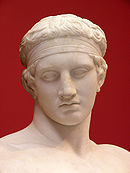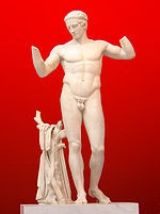
Diadumenos
Encyclopedia
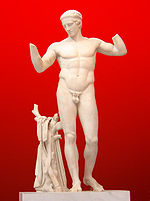
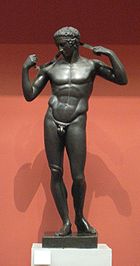
Doryphoros
The Doryphoros is one of the best known Greek sculptures of the classical era in Western Art and an early example of Greek classical contrapposto...
and Discophoros
Discophoros
The Discophoros, also spelled Discophorus, was a bronze sculpture by the classical Greek sculptor Polyclitus, creator of the Doryphoros and Diadumenos, and its many Roman marble copies...
, are the three most famous figural types of the sculptor Polyclitus, forming three basic patterns of Ancient Greek sculpture
Ancient Greek sculpture
Ancient Greek sculpture is the sculpture of Ancient Greece. Modern scholarship identifies three major stages. They were used to depict the battles, mythology, and rulers of the land known as Ancient Greece.-Geometric:...
that all present strictly idealised representations of young male athletes in a convincingly naturalistic manner.
The Diadumenos is the winner of an athletic contest at a games, still nude after the contest and lifting his arms to knot the diadem
Diadem
Diadem may refer to:*Diadem, a type of crown-Military:*HMS Diadem was a 64-gun third rate ship of the line in the Royal Navy launched in 1782 at Chatham and participated in the Battle of Cape St Vincent in 1787...
, a ribbon-band that identifies the winner and which in the bronze original of about 420 BCE would have been represented by a ribbon of bronze. The figure stands in contrapposto
Contrapposto
Contrapposto is an Italian term that means counterpose. It is used in the visual arts to describe a human figure standing with most of its weight on one foot so that its shoulders and arms twist off-axis from the hips and legs. This gives the figure a more dynamic, or alternatively relaxed...
with his weight on his right foot, his left knee slightly bent and his head inclined slightly to the right, self-contained, seeming to be lost in thought. Phidias
Phidias
Phidias or the great Pheidias , was a Greek sculptor, painter and architect, who lived in the 5th century BC, and is commonly regarded as one of the greatest of all sculptors of Classical Greece: Phidias' Statue of Zeus at Olympia was one of the Seven Wonders of the Ancient World...
was credited with a statue of a victor at Olympia
Olympia, Greece
Olympia , a sanctuary of ancient Greece in Elis, is known for having been the site of the Olympic Games in classical times, comparable in importance to the Pythian Games held in Delphi. Both games were held every Olympiad , the Olympic Games dating back possibly further than 776 BC...
in the act of tying the fillet around his head; besides Polyclitus, his successors Lysippos
Lysippos
Lysippos was a Greek sculptor of the 4th century BC. Together with Scopas and Praxiteles, he is considered one of the three greatest sculptors of the Classical Greek era, bringing transition into the Hellenistic period. Problems confront the study of Lysippos because of the difficulty of...
and Scopas
Scopas
Scopas or Skopas was an Ancient Greek sculptor and architect, born on the island of Paros. Scopas worked with Praxiteles, and he sculpted parts of the Mausoleum of Halicarnassus, especially the reliefs. He led the building of the new temple of Athena Alea at Tegea...
also created figures of this kind.
Roman copies
Both Pliny's Natural History and LucianLucian
Lucian of Samosata was a rhetorician and satirist who wrote in the Greek language. He is noted for his witty and scoffing nature.His ethnicity is disputed and is attributed as Assyrian according to Frye and Parpola, and Syrian according to Joseph....
's Philopseudes described Roman
Ancient Rome
Ancient Rome was a thriving civilization that grew on the Italian Peninsula as early as the 8th century BC. Located along the Mediterranean Sea and centered on the city of Rome, it expanded to one of the largest empires in the ancient world....
marbles of a Diadumenos copied from Greek originals in bronze
Bronze
Bronze is a metal alloy consisting primarily of copper, usually with tin as the main additive. It is hard and brittle, and it was particularly significant in antiquity, so much so that the Bronze Age was named after the metal...
, yet it was not recognized until 1878 that the Roman marble from Vaison-la-Romaine
Vaison-la-Romaine
Vaison-la-Romaine is a commune in the Vaucluse department in the Provence-Alpes-Côte d'Azur region in southeastern France....
(Roman Vasio) in the British Museum
British Museum
The British Museum is a museum of human history and culture in London. Its collections, which number more than seven million objects, are amongst the largest and most comprehensive in the world and originate from all continents, illustrating and documenting the story of human culture from its...
and two others recreate the lost Polyclitan bronze original. Pliny recorded that the Polyclitan original fetched at auction the extraordinary price of a hundred talents, an enormous sum in Antiquity, as Adolf Furtwängler
Adolf Furtwängler
Adolf Furtwängler was a famous German archaeologist, teacher, art historian and museum director. He was the father of the conductor Wilhelm Furtwängler and grandfather of the German archaeologist Andreas Furtwängler....
pointed out. Indeed, Roman marble copies must have abounded, to judge from the number of recognizable fragments and complete works, including a head at the Louvre
Louvre
The Musée du Louvre – in English, the Louvre Museum or simply the Louvre – is one of the world's largest museums, the most visited art museum in the world and a historic monument. A central landmark of Paris, it is located on the Right Bank of the Seine in the 1st arrondissement...
, a complete example at the Metropolitan Museum of Art
Metropolitan Museum of Art
The Metropolitan Museum of Art is a renowned art museum in New York City. Its permanent collection contains more than two million works, divided into nineteen curatorial departments. The main building, located on the eastern edge of Central Park along Manhattan's Museum Mile, is one of the...
, and another complete example of somewhat different character, the somewhat below lifesize Roman marble Farnese Diadumenos
Farnese Diadumenos
The Farnese Diadumenos is a 1st century AD, slightly smaller than lifesize, Roman marble copy of Polyclitus's Diadumenos sculpture. Once in the Farnese collection, it is now in the British Museum....
at the British Museum
British Museum
The British Museum is a museum of human history and culture in London. Its collections, which number more than seven million objects, are amongst the largest and most comprehensive in the world and originate from all continents, illustrating and documenting the story of human culture from its...
, which preserves the end of the ribband falling from the right hand. Freer versions were executed in reduced scale as bronze statuettes, and the head of Diadumenos-type appears on numerous Roman engraved gems.
The marble Diadumenos from Delos
Delos
The island of Delos , isolated in the centre of the roughly circular ring of islands called the Cyclades, near Mykonos, is one of the most important mythological, historical and archaeological sites in Greece...
at the National Museum, Athens (right) has the winner's cloak and his quiver laid upon the tree stump, hinting that he is the victor in an archery match, with perhaps an implied reference to Apollo
Apollo
Apollo is one of the most important and complex of the Olympian deities in Greek and Roman mythology...
, who was conceived, too, as an idealised youth.
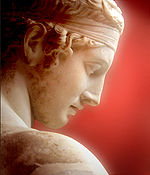
Modern reception
A mark of the continuing artistic value placed on the Diadumenos type in the modern era, once it had been reconnected with Polyclitus in 1878, may be drawn from the facts that a copy was among the sculptures ranged on the roof of the National Museum, Athens, when it was completed in 1889, and that the Esquiline VenusEsquiline Venus
The Esquiline Venus is a smaller-than-life-size Roman nude marble sculpture of a female in a sandal and headdress.-History:It was found in 1874 in Piazza Dante on the Esquiline Hill in Rome, probably part of the site of the Horti Lamiani, one of the imperial gardens, rich archaeological sources of...
has sometimes been interpreted as a female version of the diadumenos type (a diadumene, or woman tying a diadem).
